Occupational Therapy: Promoting Independence and Well-being
VerifiedAdded on 2023/04/20
|12
|3144
|380
AI Summary
This assignment explores the role and importance of occupational therapy in promoting independence and well-being. It discusses the evaluation process, intervention methods, and the unique contributions of occupational therapists. Occupational therapy helps individuals of all ages engage in daily activities and live fulfilling lives.
Contribute Materials
Your contribution can guide someone’s learning journey. Share your
documents today.
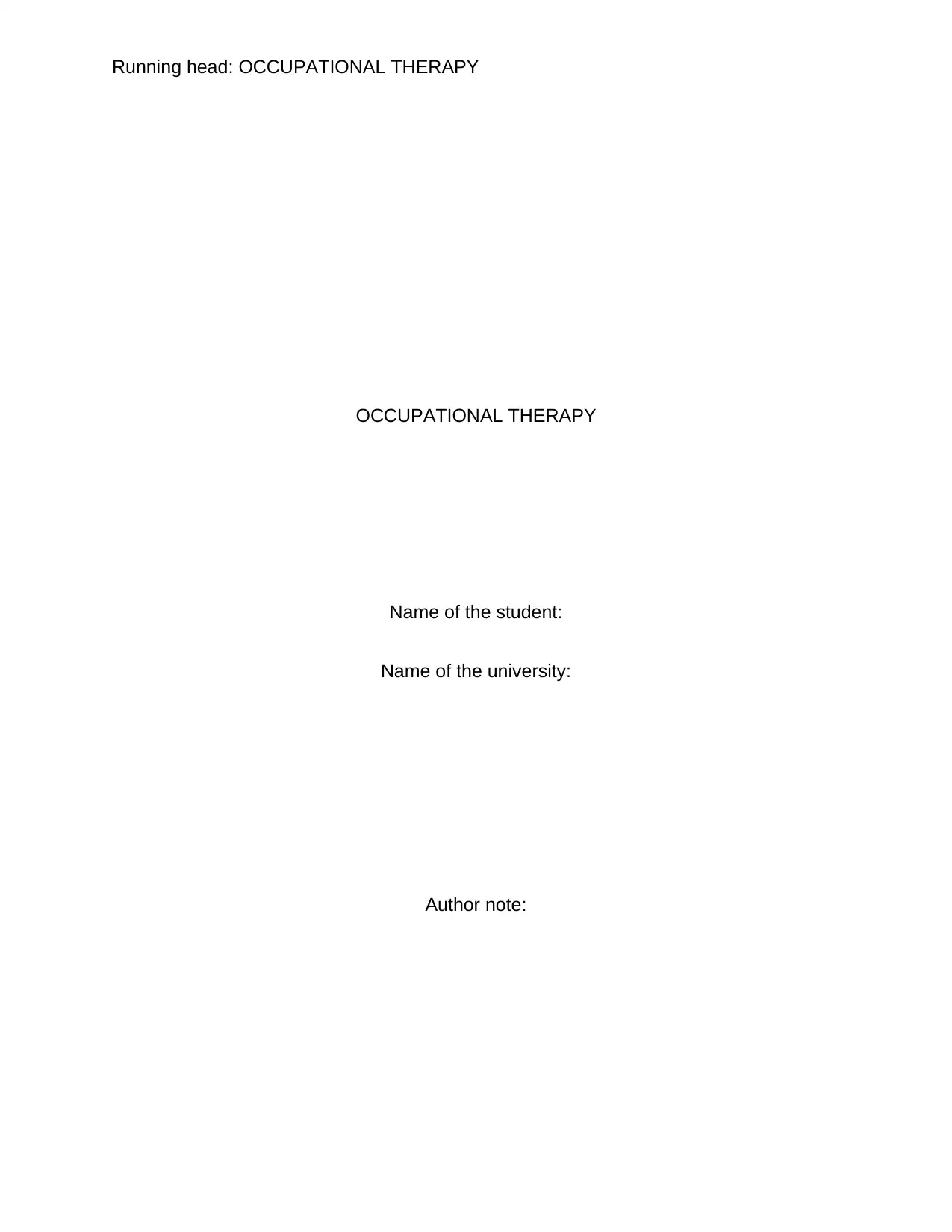
Running head: OCCUPATIONAL THERAPY
OCCUPATIONAL THERAPY
Name of the student:
Name of the university:
Author note:
OCCUPATIONAL THERAPY
Name of the student:
Name of the university:
Author note:
Secure Best Marks with AI Grader
Need help grading? Try our AI Grader for instant feedback on your assignments.
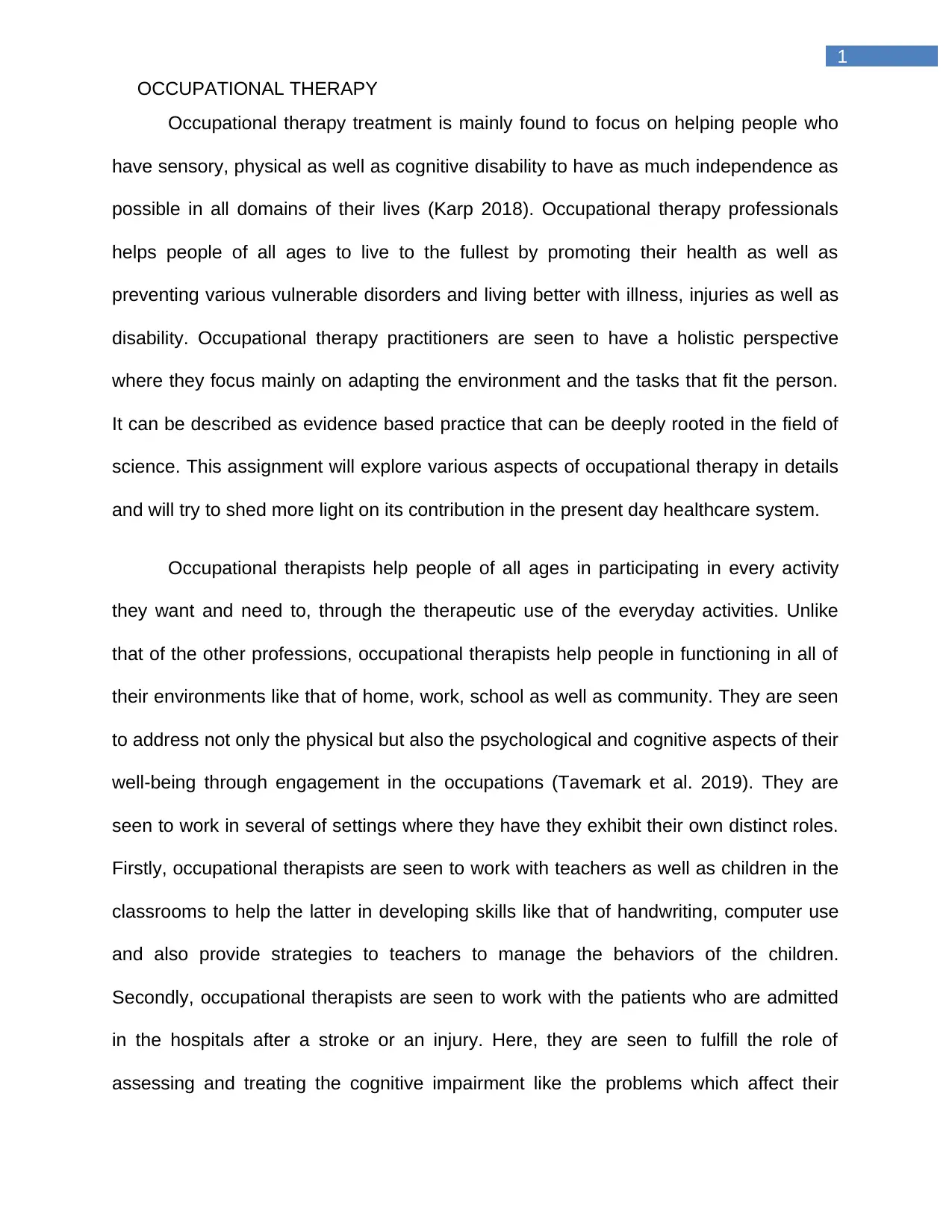
1
OCCUPATIONAL THERAPY
Occupational therapy treatment is mainly found to focus on helping people who
have sensory, physical as well as cognitive disability to have as much independence as
possible in all domains of their lives (Karp 2018). Occupational therapy professionals
helps people of all ages to live to the fullest by promoting their health as well as
preventing various vulnerable disorders and living better with illness, injuries as well as
disability. Occupational therapy practitioners are seen to have a holistic perspective
where they focus mainly on adapting the environment and the tasks that fit the person.
It can be described as evidence based practice that can be deeply rooted in the field of
science. This assignment will explore various aspects of occupational therapy in details
and will try to shed more light on its contribution in the present day healthcare system.
Occupational therapists help people of all ages in participating in every activity
they want and need to, through the therapeutic use of the everyday activities. Unlike
that of the other professions, occupational therapists help people in functioning in all of
their environments like that of home, work, school as well as community. They are seen
to address not only the physical but also the psychological and cognitive aspects of their
well-being through engagement in the occupations (Tavemark et al. 2019). They are
seen to work in several of settings where they have they exhibit their own distinct roles.
Firstly, occupational therapists are seen to work with teachers as well as children in the
classrooms to help the latter in developing skills like that of handwriting, computer use
and also provide strategies to teachers to manage the behaviors of the children.
Secondly, occupational therapists are seen to work with the patients who are admitted
in the hospitals after a stroke or an injury. Here, they are seen to fulfill the role of
assessing and treating the cognitive impairment like the problems which affect their
OCCUPATIONAL THERAPY
Occupational therapy treatment is mainly found to focus on helping people who
have sensory, physical as well as cognitive disability to have as much independence as
possible in all domains of their lives (Karp 2018). Occupational therapy professionals
helps people of all ages to live to the fullest by promoting their health as well as
preventing various vulnerable disorders and living better with illness, injuries as well as
disability. Occupational therapy practitioners are seen to have a holistic perspective
where they focus mainly on adapting the environment and the tasks that fit the person.
It can be described as evidence based practice that can be deeply rooted in the field of
science. This assignment will explore various aspects of occupational therapy in details
and will try to shed more light on its contribution in the present day healthcare system.
Occupational therapists help people of all ages in participating in every activity
they want and need to, through the therapeutic use of the everyday activities. Unlike
that of the other professions, occupational therapists help people in functioning in all of
their environments like that of home, work, school as well as community. They are seen
to address not only the physical but also the psychological and cognitive aspects of their
well-being through engagement in the occupations (Tavemark et al. 2019). They are
seen to work in several of settings where they have they exhibit their own distinct roles.
Firstly, occupational therapists are seen to work with teachers as well as children in the
classrooms to help the latter in developing skills like that of handwriting, computer use
and also provide strategies to teachers to manage the behaviors of the children.
Secondly, occupational therapists are seen to work with the patients who are admitted
in the hospitals after a stroke or an injury. Here, they are seen to fulfill the role of
assessing and treating the cognitive impairment like the problems which affect their
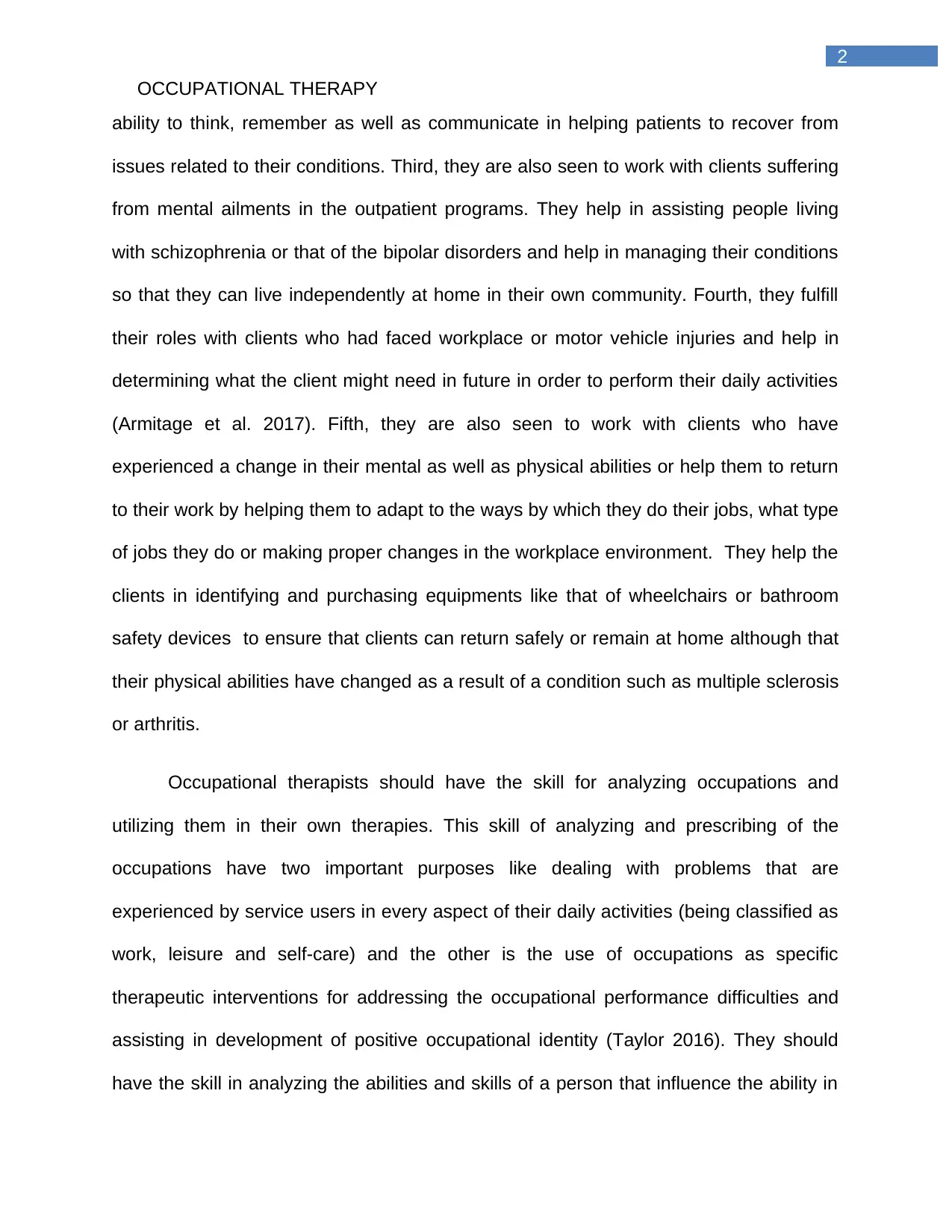
2
OCCUPATIONAL THERAPY
ability to think, remember as well as communicate in helping patients to recover from
issues related to their conditions. Third, they are also seen to work with clients suffering
from mental ailments in the outpatient programs. They help in assisting people living
with schizophrenia or that of the bipolar disorders and help in managing their conditions
so that they can live independently at home in their own community. Fourth, they fulfill
their roles with clients who had faced workplace or motor vehicle injuries and help in
determining what the client might need in future in order to perform their daily activities
(Armitage et al. 2017). Fifth, they are also seen to work with clients who have
experienced a change in their mental as well as physical abilities or help them to return
to their work by helping them to adapt to the ways by which they do their jobs, what type
of jobs they do or making proper changes in the workplace environment. They help the
clients in identifying and purchasing equipments like that of wheelchairs or bathroom
safety devices to ensure that clients can return safely or remain at home although that
their physical abilities have changed as a result of a condition such as multiple sclerosis
or arthritis.
Occupational therapists should have the skill for analyzing occupations and
utilizing them in their own therapies. This skill of analyzing and prescribing of the
occupations have two important purposes like dealing with problems that are
experienced by service users in every aspect of their daily activities (being classified as
work, leisure and self-care) and the other is the use of occupations as specific
therapeutic interventions for addressing the occupational performance difficulties and
assisting in development of positive occupational identity (Taylor 2016). They should
have the skill in analyzing the abilities and skills of a person that influence the ability in
OCCUPATIONAL THERAPY
ability to think, remember as well as communicate in helping patients to recover from
issues related to their conditions. Third, they are also seen to work with clients suffering
from mental ailments in the outpatient programs. They help in assisting people living
with schizophrenia or that of the bipolar disorders and help in managing their conditions
so that they can live independently at home in their own community. Fourth, they fulfill
their roles with clients who had faced workplace or motor vehicle injuries and help in
determining what the client might need in future in order to perform their daily activities
(Armitage et al. 2017). Fifth, they are also seen to work with clients who have
experienced a change in their mental as well as physical abilities or help them to return
to their work by helping them to adapt to the ways by which they do their jobs, what type
of jobs they do or making proper changes in the workplace environment. They help the
clients in identifying and purchasing equipments like that of wheelchairs or bathroom
safety devices to ensure that clients can return safely or remain at home although that
their physical abilities have changed as a result of a condition such as multiple sclerosis
or arthritis.
Occupational therapists should have the skill for analyzing occupations and
utilizing them in their own therapies. This skill of analyzing and prescribing of the
occupations have two important purposes like dealing with problems that are
experienced by service users in every aspect of their daily activities (being classified as
work, leisure and self-care) and the other is the use of occupations as specific
therapeutic interventions for addressing the occupational performance difficulties and
assisting in development of positive occupational identity (Taylor 2016). They should
have the skill in analyzing the abilities and skills of a person that influence the ability in

3
OCCUPATIONAL THERAPY
engaging in activities. Besides, they should also have the skill of understanding bio-
psychosocial relationships that are seen to exit between the body functions and
structures, activities, environmental factors, participation and quality of life. The second
important skill is environmental analysis and its adaptation. They need to recognize the
different physical as well as social environments that might have important beneficial or
that of detrimental effects on the service users. With the help of environmental analysis,
they would be able to provide information for the behaviors or the ideas and even
suggestions to the clients for therapeutic adaptation. Thirds, they would also need to
have efficient communication and listening skills as they need to ensure holistic well-
being of the person and not only overcoming disabilities. They need to have proper
interpersonal skills by which they would be able to listen to their patients, and also
explain to them the ways they feel or what their symptoms are. Accurate listening helps
in communicating effectively along with reflecting back on what the patient has told.
They need to spend most time with their patients or teaching them about procedures,
exercises and therapies (Hyett et al. 2016). Unless a strong therapeutic relationship and
close rapport are developed with patients, the latter would not feel comfortable in
working. So communication and listening skills are must. Fourth, they would need to
have organization as well as problem solving skills. The problems might be major as to
helping patients climb stairs or may be minor like buttoning a shirt and others. They
need to ensure that they have strong organizational skills and problem solving skills
where they can organize the needs of the patients as per the priorities and solve each
of the problems with expertise. Fifth skill is the exhibition of empathy and compassion in
ensuring compassionate care (Elf et al. 2017). Often in cases, a patient who has
OCCUPATIONAL THERAPY
engaging in activities. Besides, they should also have the skill of understanding bio-
psychosocial relationships that are seen to exit between the body functions and
structures, activities, environmental factors, participation and quality of life. The second
important skill is environmental analysis and its adaptation. They need to recognize the
different physical as well as social environments that might have important beneficial or
that of detrimental effects on the service users. With the help of environmental analysis,
they would be able to provide information for the behaviors or the ideas and even
suggestions to the clients for therapeutic adaptation. Thirds, they would also need to
have efficient communication and listening skills as they need to ensure holistic well-
being of the person and not only overcoming disabilities. They need to have proper
interpersonal skills by which they would be able to listen to their patients, and also
explain to them the ways they feel or what their symptoms are. Accurate listening helps
in communicating effectively along with reflecting back on what the patient has told.
They need to spend most time with their patients or teaching them about procedures,
exercises and therapies (Hyett et al. 2016). Unless a strong therapeutic relationship and
close rapport are developed with patients, the latter would not feel comfortable in
working. So communication and listening skills are must. Fourth, they would need to
have organization as well as problem solving skills. The problems might be major as to
helping patients climb stairs or may be minor like buttoning a shirt and others. They
need to ensure that they have strong organizational skills and problem solving skills
where they can organize the needs of the patients as per the priorities and solve each
of the problems with expertise. Fifth skill is the exhibition of empathy and compassion in
ensuring compassionate care (Elf et al. 2017). Often in cases, a patient who has
Paraphrase This Document
Need a fresh take? Get an instant paraphrase of this document with our AI Paraphraser
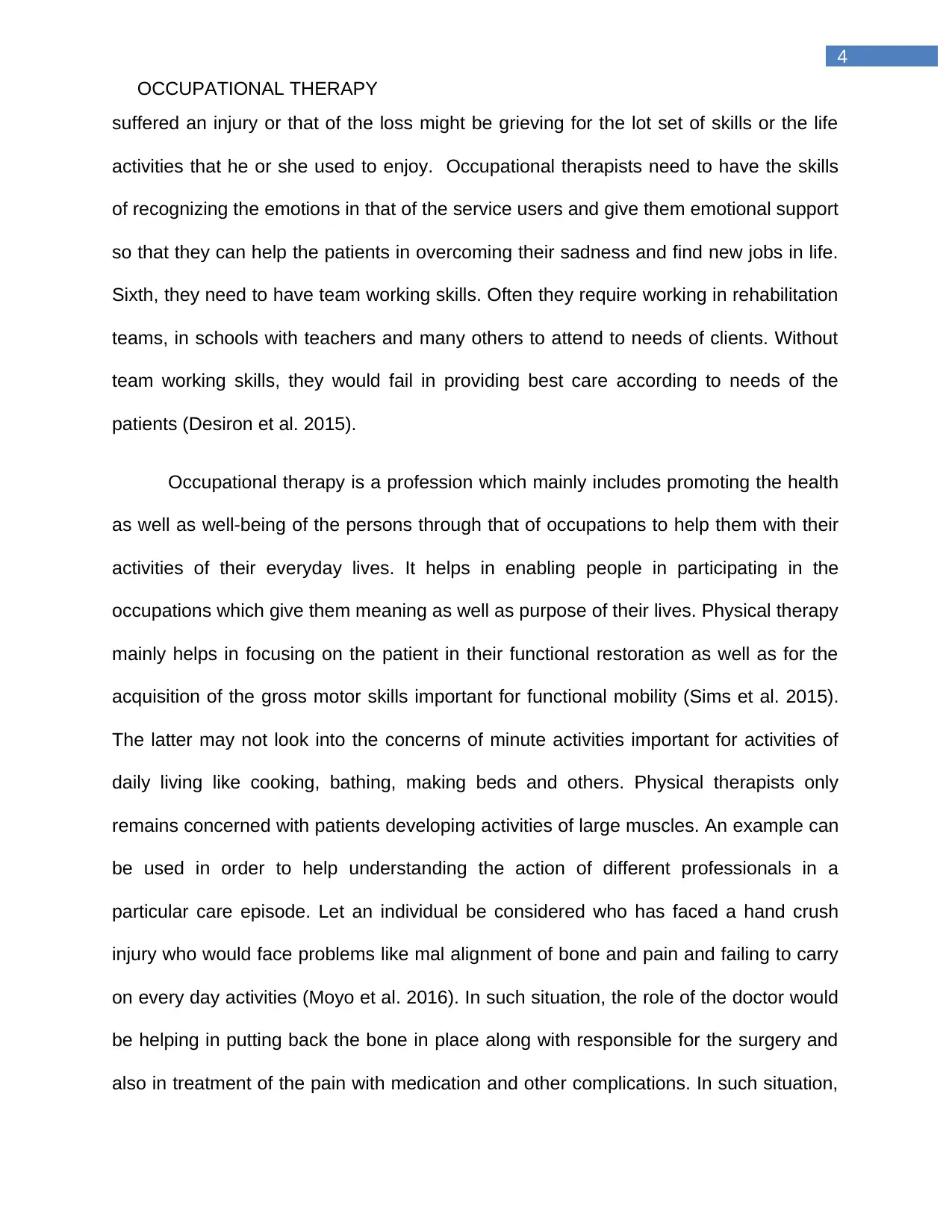
4
OCCUPATIONAL THERAPY
suffered an injury or that of the loss might be grieving for the lot set of skills or the life
activities that he or she used to enjoy. Occupational therapists need to have the skills
of recognizing the emotions in that of the service users and give them emotional support
so that they can help the patients in overcoming their sadness and find new jobs in life.
Sixth, they need to have team working skills. Often they require working in rehabilitation
teams, in schools with teachers and many others to attend to needs of clients. Without
team working skills, they would fail in providing best care according to needs of the
patients (Desiron et al. 2015).
Occupational therapy is a profession which mainly includes promoting the health
as well as well-being of the persons through that of occupations to help them with their
activities of their everyday lives. It helps in enabling people in participating in the
occupations which give them meaning as well as purpose of their lives. Physical therapy
mainly helps in focusing on the patient in their functional restoration as well as for the
acquisition of the gross motor skills important for functional mobility (Sims et al. 2015).
The latter may not look into the concerns of minute activities important for activities of
daily living like cooking, bathing, making beds and others. Physical therapists only
remains concerned with patients developing activities of large muscles. An example can
be used in order to help understanding the action of different professionals in a
particular care episode. Let an individual be considered who has faced a hand crush
injury who would face problems like mal alignment of bone and pain and failing to carry
on every day activities (Moyo et al. 2016). In such situation, the role of the doctor would
be helping in putting back the bone in place along with responsible for the surgery and
also in treatment of the pain with medication and other complications. In such situation,
OCCUPATIONAL THERAPY
suffered an injury or that of the loss might be grieving for the lot set of skills or the life
activities that he or she used to enjoy. Occupational therapists need to have the skills
of recognizing the emotions in that of the service users and give them emotional support
so that they can help the patients in overcoming their sadness and find new jobs in life.
Sixth, they need to have team working skills. Often they require working in rehabilitation
teams, in schools with teachers and many others to attend to needs of clients. Without
team working skills, they would fail in providing best care according to needs of the
patients (Desiron et al. 2015).
Occupational therapy is a profession which mainly includes promoting the health
as well as well-being of the persons through that of occupations to help them with their
activities of their everyday lives. It helps in enabling people in participating in the
occupations which give them meaning as well as purpose of their lives. Physical therapy
mainly helps in focusing on the patient in their functional restoration as well as for the
acquisition of the gross motor skills important for functional mobility (Sims et al. 2015).
The latter may not look into the concerns of minute activities important for activities of
daily living like cooking, bathing, making beds and others. Physical therapists only
remains concerned with patients developing activities of large muscles. An example can
be used in order to help understanding the action of different professionals in a
particular care episode. Let an individual be considered who has faced a hand crush
injury who would face problems like mal alignment of bone and pain and failing to carry
on every day activities (Moyo et al. 2016). In such situation, the role of the doctor would
be helping in putting back the bone in place along with responsible for the surgery and
also in treatment of the pain with medication and other complications. In such situation,
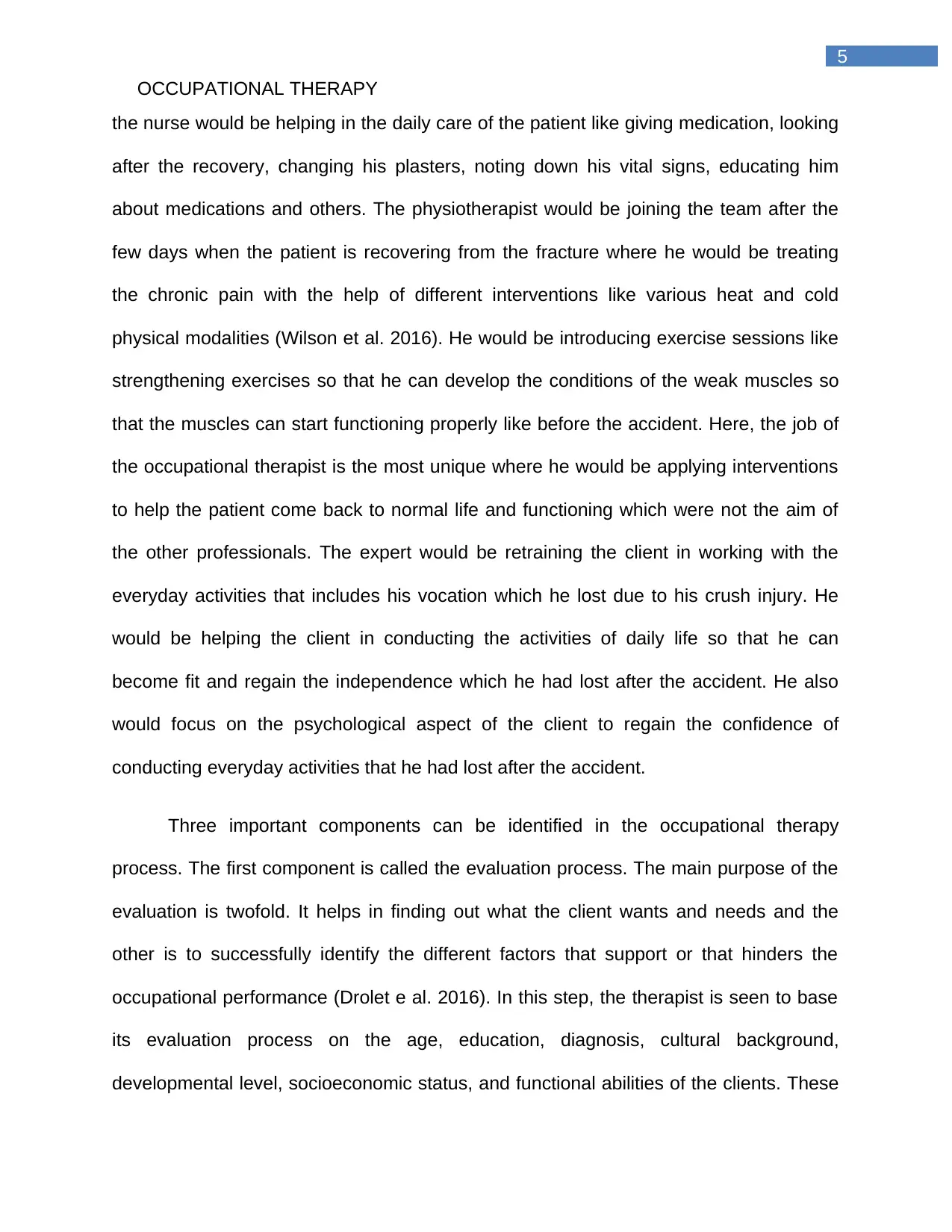
5
OCCUPATIONAL THERAPY
the nurse would be helping in the daily care of the patient like giving medication, looking
after the recovery, changing his plasters, noting down his vital signs, educating him
about medications and others. The physiotherapist would be joining the team after the
few days when the patient is recovering from the fracture where he would be treating
the chronic pain with the help of different interventions like various heat and cold
physical modalities (Wilson et al. 2016). He would be introducing exercise sessions like
strengthening exercises so that he can develop the conditions of the weak muscles so
that the muscles can start functioning properly like before the accident. Here, the job of
the occupational therapist is the most unique where he would be applying interventions
to help the patient come back to normal life and functioning which were not the aim of
the other professionals. The expert would be retraining the client in working with the
everyday activities that includes his vocation which he lost due to his crush injury. He
would be helping the client in conducting the activities of daily life so that he can
become fit and regain the independence which he had lost after the accident. He also
would focus on the psychological aspect of the client to regain the confidence of
conducting everyday activities that he had lost after the accident.
Three important components can be identified in the occupational therapy
process. The first component is called the evaluation process. The main purpose of the
evaluation is twofold. It helps in finding out what the client wants and needs and the
other is to successfully identify the different factors that support or that hinders the
occupational performance (Drolet e al. 2016). In this step, the therapist is seen to base
its evaluation process on the age, education, diagnosis, cultural background,
developmental level, socioeconomic status, and functional abilities of the clients. These
OCCUPATIONAL THERAPY
the nurse would be helping in the daily care of the patient like giving medication, looking
after the recovery, changing his plasters, noting down his vital signs, educating him
about medications and others. The physiotherapist would be joining the team after the
few days when the patient is recovering from the fracture where he would be treating
the chronic pain with the help of different interventions like various heat and cold
physical modalities (Wilson et al. 2016). He would be introducing exercise sessions like
strengthening exercises so that he can develop the conditions of the weak muscles so
that the muscles can start functioning properly like before the accident. Here, the job of
the occupational therapist is the most unique where he would be applying interventions
to help the patient come back to normal life and functioning which were not the aim of
the other professionals. The expert would be retraining the client in working with the
everyday activities that includes his vocation which he lost due to his crush injury. He
would be helping the client in conducting the activities of daily life so that he can
become fit and regain the independence which he had lost after the accident. He also
would focus on the psychological aspect of the client to regain the confidence of
conducting everyday activities that he had lost after the accident.
Three important components can be identified in the occupational therapy
process. The first component is called the evaluation process. The main purpose of the
evaluation is twofold. It helps in finding out what the client wants and needs and the
other is to successfully identify the different factors that support or that hinders the
occupational performance (Drolet e al. 2016). In this step, the therapist is seen to base
its evaluation process on the age, education, diagnosis, cultural background,
developmental level, socioeconomic status, and functional abilities of the clients. These
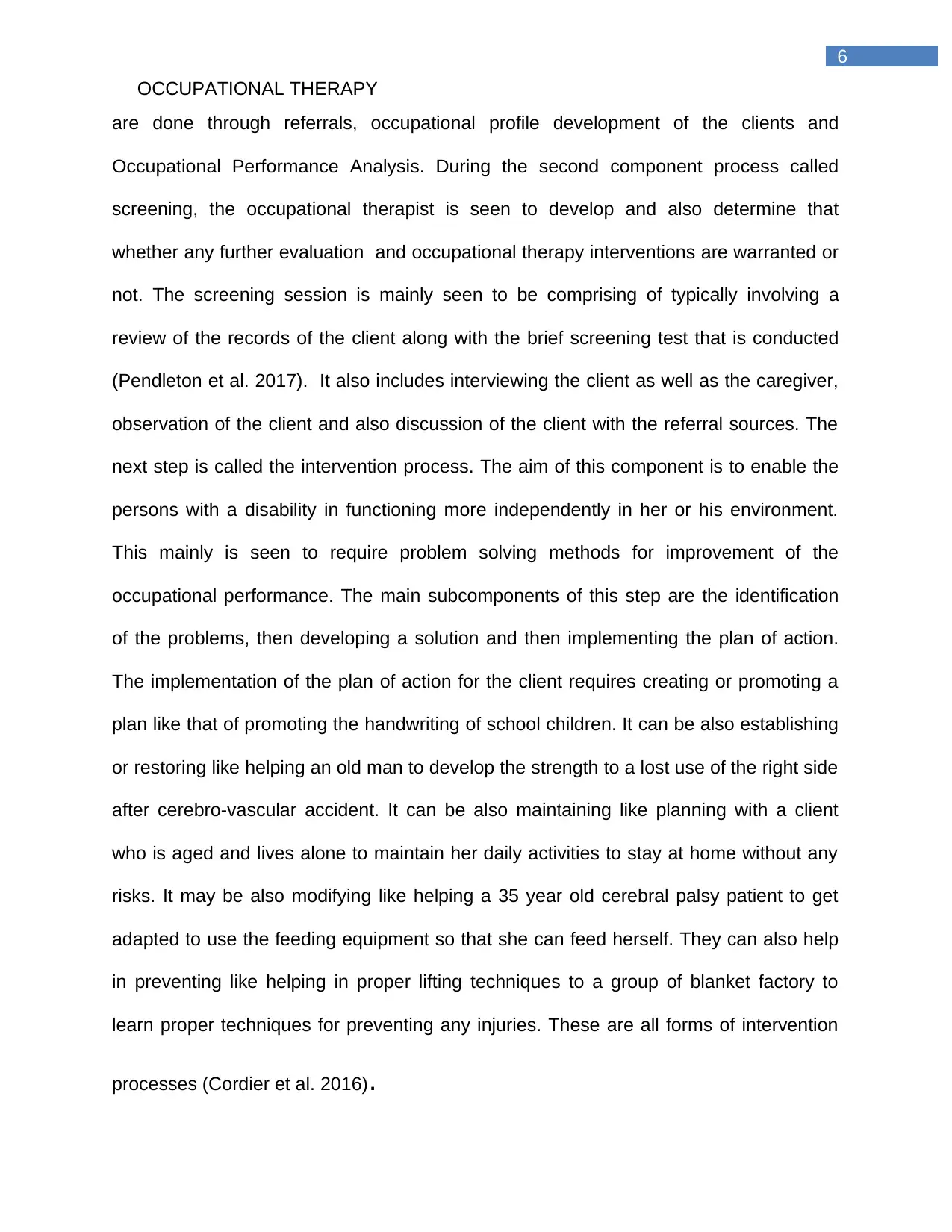
6
OCCUPATIONAL THERAPY
are done through referrals, occupational profile development of the clients and
Occupational Performance Analysis. During the second component process called
screening, the occupational therapist is seen to develop and also determine that
whether any further evaluation and occupational therapy interventions are warranted or
not. The screening session is mainly seen to be comprising of typically involving a
review of the records of the client along with the brief screening test that is conducted
(Pendleton et al. 2017). It also includes interviewing the client as well as the caregiver,
observation of the client and also discussion of the client with the referral sources. The
next step is called the intervention process. The aim of this component is to enable the
persons with a disability in functioning more independently in her or his environment.
This mainly is seen to require problem solving methods for improvement of the
occupational performance. The main subcomponents of this step are the identification
of the problems, then developing a solution and then implementing the plan of action.
The implementation of the plan of action for the client requires creating or promoting a
plan like that of promoting the handwriting of school children. It can be also establishing
or restoring like helping an old man to develop the strength to a lost use of the right side
after cerebro-vascular accident. It can be also maintaining like planning with a client
who is aged and lives alone to maintain her daily activities to stay at home without any
risks. It may be also modifying like helping a 35 year old cerebral palsy patient to get
adapted to use the feeding equipment so that she can feed herself. They can also help
in preventing like helping in proper lifting techniques to a group of blanket factory to
learn proper techniques for preventing any injuries. These are all forms of intervention
processes (Cordier et al. 2016).
OCCUPATIONAL THERAPY
are done through referrals, occupational profile development of the clients and
Occupational Performance Analysis. During the second component process called
screening, the occupational therapist is seen to develop and also determine that
whether any further evaluation and occupational therapy interventions are warranted or
not. The screening session is mainly seen to be comprising of typically involving a
review of the records of the client along with the brief screening test that is conducted
(Pendleton et al. 2017). It also includes interviewing the client as well as the caregiver,
observation of the client and also discussion of the client with the referral sources. The
next step is called the intervention process. The aim of this component is to enable the
persons with a disability in functioning more independently in her or his environment.
This mainly is seen to require problem solving methods for improvement of the
occupational performance. The main subcomponents of this step are the identification
of the problems, then developing a solution and then implementing the plan of action.
The implementation of the plan of action for the client requires creating or promoting a
plan like that of promoting the handwriting of school children. It can be also establishing
or restoring like helping an old man to develop the strength to a lost use of the right side
after cerebro-vascular accident. It can be also maintaining like planning with a client
who is aged and lives alone to maintain her daily activities to stay at home without any
risks. It may be also modifying like helping a 35 year old cerebral palsy patient to get
adapted to use the feeding equipment so that she can feed herself. They can also help
in preventing like helping in proper lifting techniques to a group of blanket factory to
learn proper techniques for preventing any injuries. These are all forms of intervention
processes (Cordier et al. 2016).
Secure Best Marks with AI Grader
Need help grading? Try our AI Grader for instant feedback on your assignments.
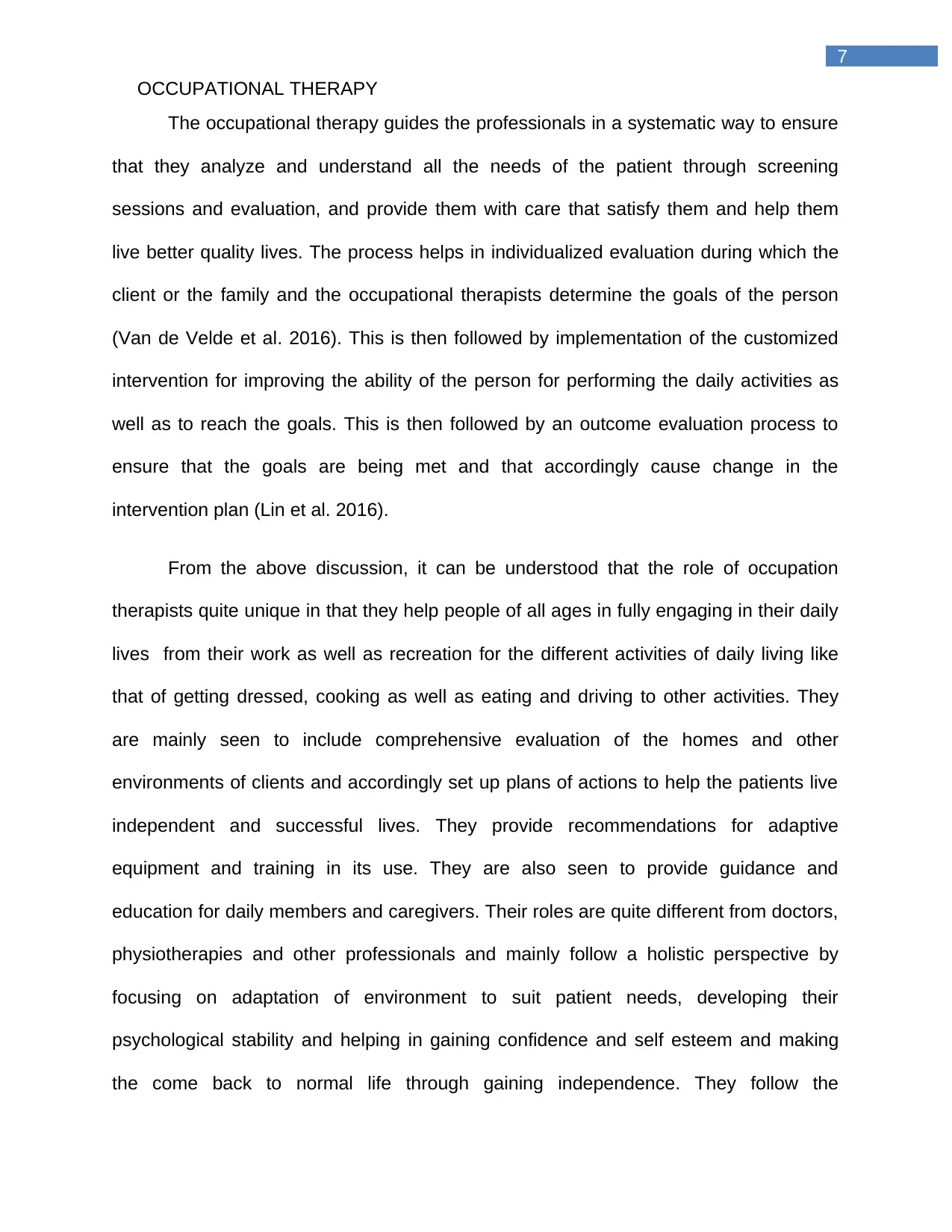
7
OCCUPATIONAL THERAPY
The occupational therapy guides the professionals in a systematic way to ensure
that they analyze and understand all the needs of the patient through screening
sessions and evaluation, and provide them with care that satisfy them and help them
live better quality lives. The process helps in individualized evaluation during which the
client or the family and the occupational therapists determine the goals of the person
(Van de Velde et al. 2016). This is then followed by implementation of the customized
intervention for improving the ability of the person for performing the daily activities as
well as to reach the goals. This is then followed by an outcome evaluation process to
ensure that the goals are being met and that accordingly cause change in the
intervention plan (Lin et al. 2016).
From the above discussion, it can be understood that the role of occupation
therapists quite unique in that they help people of all ages in fully engaging in their daily
lives from their work as well as recreation for the different activities of daily living like
that of getting dressed, cooking as well as eating and driving to other activities. They
are mainly seen to include comprehensive evaluation of the homes and other
environments of clients and accordingly set up plans of actions to help the patients live
independent and successful lives. They provide recommendations for adaptive
equipment and training in its use. They are also seen to provide guidance and
education for daily members and caregivers. Their roles are quite different from doctors,
physiotherapies and other professionals and mainly follow a holistic perspective by
focusing on adaptation of environment to suit patient needs, developing their
psychological stability and helping in gaining confidence and self esteem and making
the come back to normal life through gaining independence. They follow the
OCCUPATIONAL THERAPY
The occupational therapy guides the professionals in a systematic way to ensure
that they analyze and understand all the needs of the patient through screening
sessions and evaluation, and provide them with care that satisfy them and help them
live better quality lives. The process helps in individualized evaluation during which the
client or the family and the occupational therapists determine the goals of the person
(Van de Velde et al. 2016). This is then followed by implementation of the customized
intervention for improving the ability of the person for performing the daily activities as
well as to reach the goals. This is then followed by an outcome evaluation process to
ensure that the goals are being met and that accordingly cause change in the
intervention plan (Lin et al. 2016).
From the above discussion, it can be understood that the role of occupation
therapists quite unique in that they help people of all ages in fully engaging in their daily
lives from their work as well as recreation for the different activities of daily living like
that of getting dressed, cooking as well as eating and driving to other activities. They
are mainly seen to include comprehensive evaluation of the homes and other
environments of clients and accordingly set up plans of actions to help the patients live
independent and successful lives. They provide recommendations for adaptive
equipment and training in its use. They are also seen to provide guidance and
education for daily members and caregivers. Their roles are quite different from doctors,
physiotherapies and other professionals and mainly follow a holistic perspective by
focusing on adaptation of environment to suit patient needs, developing their
psychological stability and helping in gaining confidence and self esteem and making
the come back to normal life through gaining independence. They follow the

8
OCCUPATIONAL THERAPY
components of screening, evaluation and intervention implementation to ensure that
they can provide best service and helping people to come back to normal lives.
OCCUPATIONAL THERAPY
components of screening, evaluation and intervention implementation to ensure that
they can provide best service and helping people to come back to normal lives.
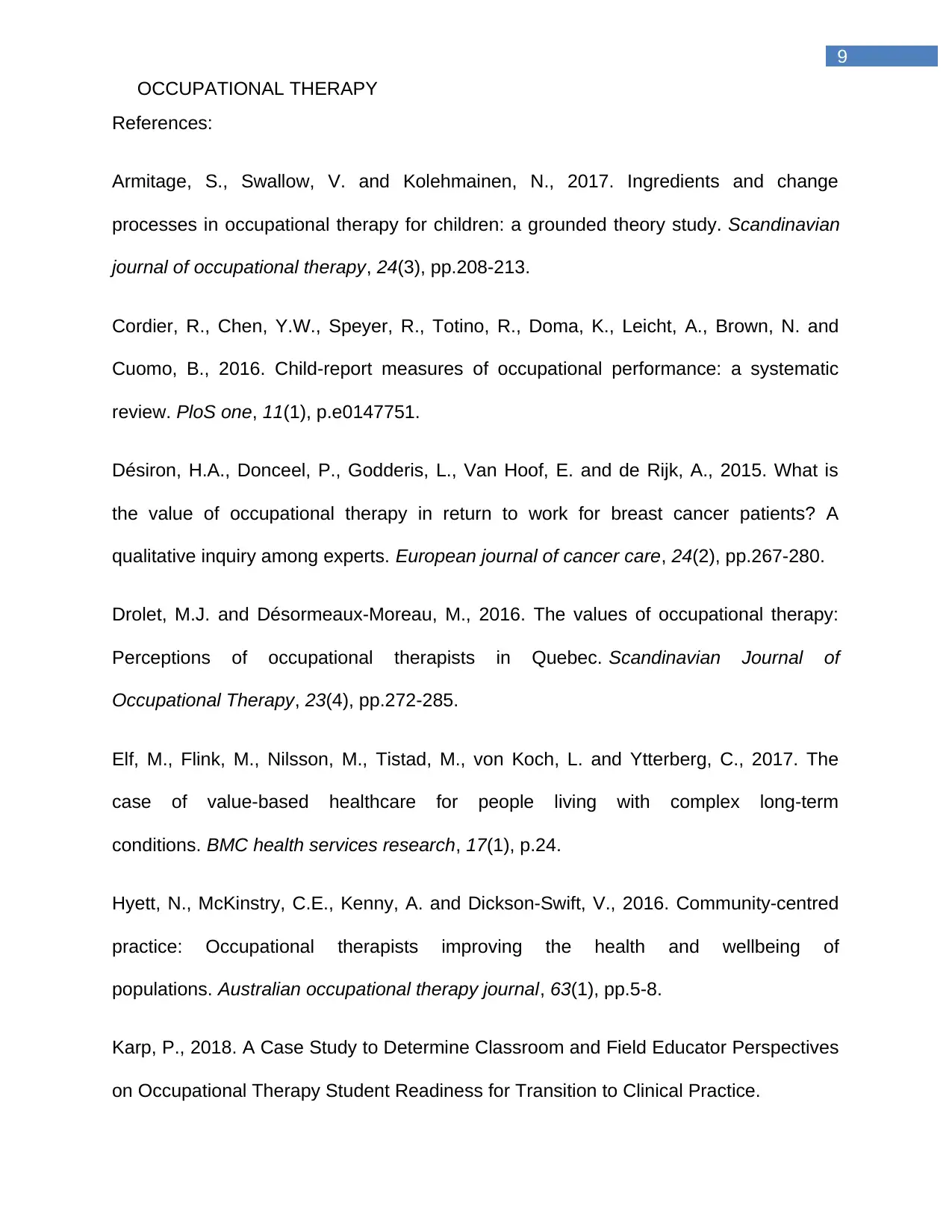
9
OCCUPATIONAL THERAPY
References:
Armitage, S., Swallow, V. and Kolehmainen, N., 2017. Ingredients and change
processes in occupational therapy for children: a grounded theory study. Scandinavian
journal of occupational therapy, 24(3), pp.208-213.
Cordier, R., Chen, Y.W., Speyer, R., Totino, R., Doma, K., Leicht, A., Brown, N. and
Cuomo, B., 2016. Child-report measures of occupational performance: a systematic
review. PloS one, 11(1), p.e0147751.
Désiron, H.A., Donceel, P., Godderis, L., Van Hoof, E. and de Rijk, A., 2015. What is
the value of occupational therapy in return to work for breast cancer patients? A
qualitative inquiry among experts. European journal of cancer care, 24(2), pp.267-280.
Drolet, M.J. and Désormeaux-Moreau, M., 2016. The values of occupational therapy:
Perceptions of occupational therapists in Quebec. Scandinavian Journal of
Occupational Therapy, 23(4), pp.272-285.
Elf, M., Flink, M., Nilsson, M., Tistad, M., von Koch, L. and Ytterberg, C., 2017. The
case of value-based healthcare for people living with complex long-term
conditions. BMC health services research, 17(1), p.24.
Hyett, N., McKinstry, C.E., Kenny, A. and Dickson-Swift, V., 2016. Community-centred
practice: Occupational therapists improving the health and wellbeing of
populations. Australian occupational therapy journal, 63(1), pp.5-8.
Karp, P., 2018. A Case Study to Determine Classroom and Field Educator Perspectives
on Occupational Therapy Student Readiness for Transition to Clinical Practice.
OCCUPATIONAL THERAPY
References:
Armitage, S., Swallow, V. and Kolehmainen, N., 2017. Ingredients and change
processes in occupational therapy for children: a grounded theory study. Scandinavian
journal of occupational therapy, 24(3), pp.208-213.
Cordier, R., Chen, Y.W., Speyer, R., Totino, R., Doma, K., Leicht, A., Brown, N. and
Cuomo, B., 2016. Child-report measures of occupational performance: a systematic
review. PloS one, 11(1), p.e0147751.
Désiron, H.A., Donceel, P., Godderis, L., Van Hoof, E. and de Rijk, A., 2015. What is
the value of occupational therapy in return to work for breast cancer patients? A
qualitative inquiry among experts. European journal of cancer care, 24(2), pp.267-280.
Drolet, M.J. and Désormeaux-Moreau, M., 2016. The values of occupational therapy:
Perceptions of occupational therapists in Quebec. Scandinavian Journal of
Occupational Therapy, 23(4), pp.272-285.
Elf, M., Flink, M., Nilsson, M., Tistad, M., von Koch, L. and Ytterberg, C., 2017. The
case of value-based healthcare for people living with complex long-term
conditions. BMC health services research, 17(1), p.24.
Hyett, N., McKinstry, C.E., Kenny, A. and Dickson-Swift, V., 2016. Community-centred
practice: Occupational therapists improving the health and wellbeing of
populations. Australian occupational therapy journal, 63(1), pp.5-8.
Karp, P., 2018. A Case Study to Determine Classroom and Field Educator Perspectives
on Occupational Therapy Student Readiness for Transition to Clinical Practice.
Paraphrase This Document
Need a fresh take? Get an instant paraphrase of this document with our AI Paraphraser
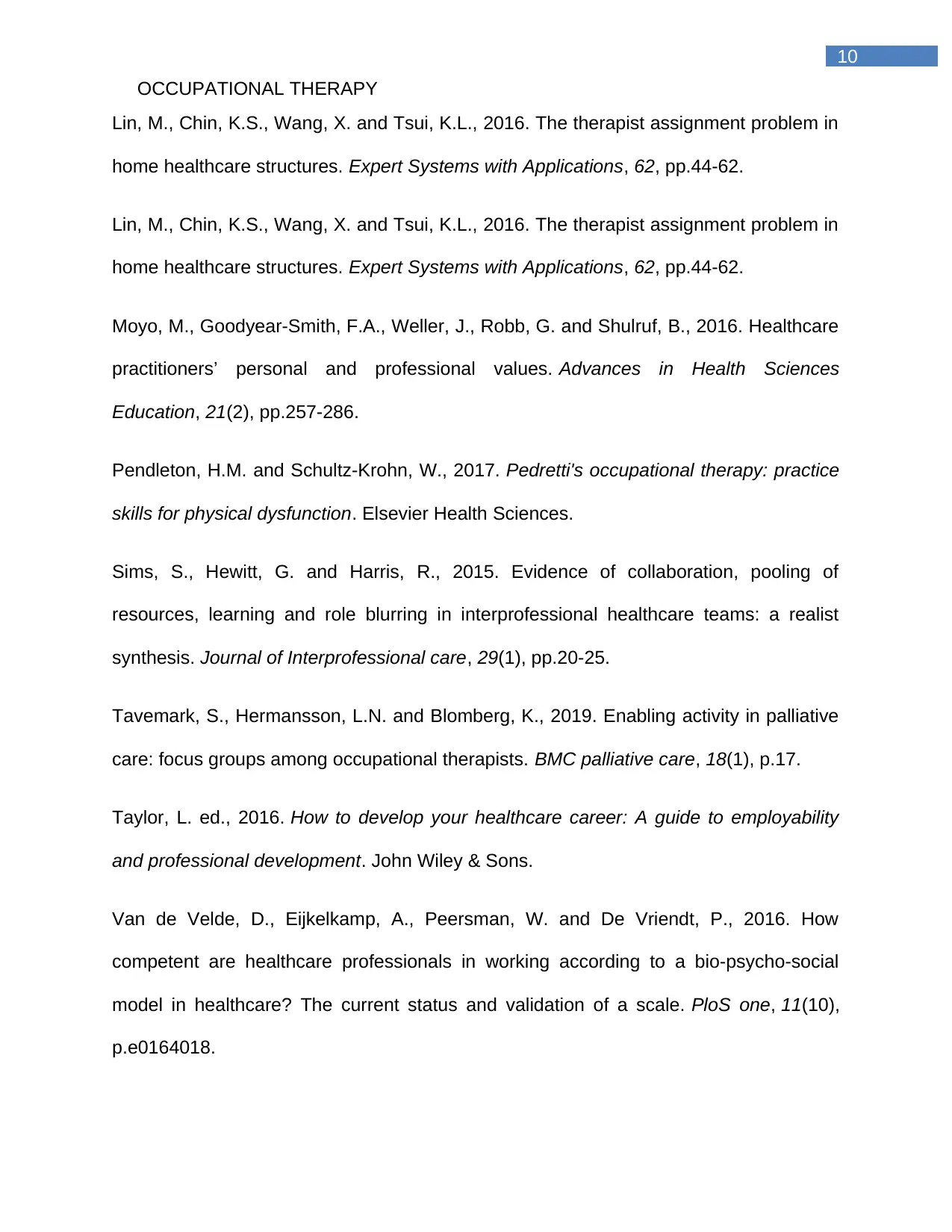
10
OCCUPATIONAL THERAPY
Lin, M., Chin, K.S., Wang, X. and Tsui, K.L., 2016. The therapist assignment problem in
home healthcare structures. Expert Systems with Applications, 62, pp.44-62.
Lin, M., Chin, K.S., Wang, X. and Tsui, K.L., 2016. The therapist assignment problem in
home healthcare structures. Expert Systems with Applications, 62, pp.44-62.
Moyo, M., Goodyear-Smith, F.A., Weller, J., Robb, G. and Shulruf, B., 2016. Healthcare
practitioners’ personal and professional values. Advances in Health Sciences
Education, 21(2), pp.257-286.
Pendleton, H.M. and Schultz-Krohn, W., 2017. Pedretti's occupational therapy: practice
skills for physical dysfunction. Elsevier Health Sciences.
Sims, S., Hewitt, G. and Harris, R., 2015. Evidence of collaboration, pooling of
resources, learning and role blurring in interprofessional healthcare teams: a realist
synthesis. Journal of Interprofessional care, 29(1), pp.20-25.
Tavemark, S., Hermansson, L.N. and Blomberg, K., 2019. Enabling activity in palliative
care: focus groups among occupational therapists. BMC palliative care, 18(1), p.17.
Taylor, L. ed., 2016. How to develop your healthcare career: A guide to employability
and professional development. John Wiley & Sons.
Van de Velde, D., Eijkelkamp, A., Peersman, W. and De Vriendt, P., 2016. How
competent are healthcare professionals in working according to a bio-psycho-social
model in healthcare? The current status and validation of a scale. PloS one, 11(10),
p.e0164018.
OCCUPATIONAL THERAPY
Lin, M., Chin, K.S., Wang, X. and Tsui, K.L., 2016. The therapist assignment problem in
home healthcare structures. Expert Systems with Applications, 62, pp.44-62.
Lin, M., Chin, K.S., Wang, X. and Tsui, K.L., 2016. The therapist assignment problem in
home healthcare structures. Expert Systems with Applications, 62, pp.44-62.
Moyo, M., Goodyear-Smith, F.A., Weller, J., Robb, G. and Shulruf, B., 2016. Healthcare
practitioners’ personal and professional values. Advances in Health Sciences
Education, 21(2), pp.257-286.
Pendleton, H.M. and Schultz-Krohn, W., 2017. Pedretti's occupational therapy: practice
skills for physical dysfunction. Elsevier Health Sciences.
Sims, S., Hewitt, G. and Harris, R., 2015. Evidence of collaboration, pooling of
resources, learning and role blurring in interprofessional healthcare teams: a realist
synthesis. Journal of Interprofessional care, 29(1), pp.20-25.
Tavemark, S., Hermansson, L.N. and Blomberg, K., 2019. Enabling activity in palliative
care: focus groups among occupational therapists. BMC palliative care, 18(1), p.17.
Taylor, L. ed., 2016. How to develop your healthcare career: A guide to employability
and professional development. John Wiley & Sons.
Van de Velde, D., Eijkelkamp, A., Peersman, W. and De Vriendt, P., 2016. How
competent are healthcare professionals in working according to a bio-psycho-social
model in healthcare? The current status and validation of a scale. PloS one, 11(10),
p.e0164018.

11
OCCUPATIONAL THERAPY
Wilson, C., Bungay, H., Munn-Giddings, C. and Boyce, M., 2016. Healthcare
professionals’ perceptions of the value and impact of the arts in healthcare settings: A
critical review of the literature. International journal of nursing studies, 56, pp.90-101.
OCCUPATIONAL THERAPY
Wilson, C., Bungay, H., Munn-Giddings, C. and Boyce, M., 2016. Healthcare
professionals’ perceptions of the value and impact of the arts in healthcare settings: A
critical review of the literature. International journal of nursing studies, 56, pp.90-101.
1 out of 12
![[object Object]](/_next/static/media/star-bottom.7253800d.svg)




